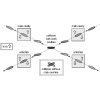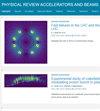蟹腔中的射频噪声导致的横向幅射增长:理论、测量、治疗和高亮度大型强子对撞机估计值
IF 1.8
3区 物理与天体物理
Q3 PHYSICS, NUCLEAR
Physical Review Accelerators and Beams
Pub Date : 2024-05-06
DOI:10.1103/physrevaccelbeams.27.051001
引用次数: 0
摘要
高亮度大型强子对撞机(HL-LHC)升级计划从2029年起开始运行,其目标是将每束质子的强度(2.2×1011)提高一倍,并将β*(两个高亮度探测器,即ATLAS和CMS的β值)降低到15厘米,从而使记录到的对撞的综合数量增加十倍。这种记录碰撞的增加将大大加快新的发现和探索。蟹腔是大型强子对撞机升级的重要组成部分,将有力地促进记录对撞次数的增加。然而,通过蟹腔射频(rf)系统注入的噪声可能会导致横向幅射显著增长,并限制光度寿命。我们在之前的工作中提出了横向幅射增长与射频噪声之间的理论形式。在这篇后续论文中,我们总结了在欧洲核子研究中心的超质子同步加速器(SPS)中进行的测量,这些测量验证了这一理论,我们提出了使用最先进的射频和低电平射频(LLRF)技术对幅射增长率的估计,并设定了射频噪声规格,以实现可接受的性能。我们需要一个新颖的专用反馈系统,通过蟹腔来减缓发射率的增长。在这项工作中,我们开发了一种理论形式来评估任何对撞机中这种反馈系统的性能,确定了限制元件,提出了仿真结果来验证这些研究,并得出了实施这种反馈系统的HL-LHC的关键设计参数。本文章由计算机程序翻译,如有差异,请以英文原文为准。

Transverse emittance growth due to rf noise in crab cavities: Theory, measurements, cure, and high luminosity LHC estimates
The High-Luminosity LHC (HL-LHC) upgrade with planned operation from 2029 onward has a goal of achieving a tenfold increase in the integrated number of recorded collisions thanks to a doubling of the intensity per bunch ( protons) and a reduction of (the value in the two high luminosity detectors, namely ATLAS and CMS) to 15 cm. Such an increase in recorded collisions would significantly expedite new discoveries and exploration. Crab cavities are an important component of the HL-LHC upgrade and will contribute strongly to achieving an increase in the number of recorded collisions. However, noise injected through the crab cavity radio frequency (rf) system could cause significant transverse emittance growth and limit luminosity lifetime. We presented a theoretical formalism relating transverse emittance growth to rf noise in an earlier work. In this follow-up paper, we summarize measurements in the super-proton synchrotron (SPS) at CERN that validate the theory, we present estimates of the emittance growth rates using state-of-the-art rf and low-level rf (LLRF) technologies, and we set the rf noise specifications to achieve acceptable performance. A novel dedicated feedback system acting through the crab cavities to mitigate emittance growth will be required. In this work, we develop a theoretical formalism to evaluate the performance of such a feedback system in any collider, identify limiting components, present simulation results to validate these studies, and derive key design parameters for an HL-LHC implementation of such a feedback system.
求助全文
通过发布文献求助,成功后即可免费获取论文全文。
去求助
来源期刊

Physical Review Accelerators and Beams
Physics and Astronomy-Surfaces and Interfaces
CiteScore
3.90
自引率
23.50%
发文量
158
审稿时长
23 weeks
期刊介绍:
Physical Review Special Topics - Accelerators and Beams (PRST-AB) is a peer-reviewed, purely electronic journal, distributed without charge to readers and funded by sponsors from national and international laboratories and other partners. The articles are published by the American Physical Society under the terms of the Creative Commons Attribution 3.0 License.
It covers the full range of accelerator science and technology; subsystem and component technologies; beam dynamics; accelerator applications; and design, operation, and improvement of accelerators used in science and industry. This includes accelerators for high-energy and nuclear physics, synchrotron-radiation production, spallation neutron sources, medical therapy, and intense-beam applications.
 求助内容:
求助内容: 应助结果提醒方式:
应助结果提醒方式:


